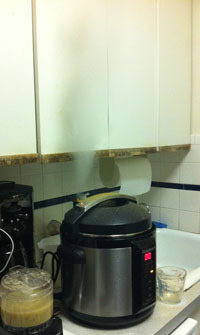What Is A Pressure Cooker?
You've probably heard people talking about a pressure cooker, whether it's your friend who is always on the forefront of new culinary trends, a hip new chef experimenting in molecular gastronomy, or someone at your most recent dinner party telling you about this weird "slow cooker" they just heard about. In recent years, these devices once relegated to restaurant kitchens have started to become more commonly used in home kitchens.
Dating back to the 17th century, pressure cookers are somewhat of a mystery topic for cooks, despite the fact that they've been around for so long. If you've ever heard someone talking about them before, you may have also have noted a hint of fear in their voice, mainly because so many people are unaware of what they are and how they work. Put simply, pressure cookers are basically vessels that cook foods at very high temperatures, using liquid as a medium. Our friends The Modernist Cuisine Team at Home explain,"A pressure cooker is essentially just a pot with a semi-sealed, lockable lid and a valve that controls the pressure inside. It works by capturing steam that, as it builds up, increases the pressure in the vessel. The pressure increase in turn raises the boiling point of water."
So pressure cookers use high pressure to cook foods, but what's the benefit of using them? The basic way to understand it is that with the higher boiling point, the cooking temperatures are higher. Co-founder and author of Modernist Cuisine Nathan Myhrvold explains, "A pressure cooker cooks food about 40-50 degrees hotter than in an open pot," and higher cooking temperatures lead to faster cooking times.
Pressure cookers = higher pressure + higher boiling point = faster cooking times
As the liquid in the pressure cooker begins to boil, the vessel will allow the pressure to rise until an ideal level is reached, at which point the lid will lock into place and the cooking process will begin. With the lid locked in place, the pressure cooker traps in the steam from cooking and prevents the liquid from evaporating. Once the cooking process is done, the air vent unlocks from the lid and slowly and safely releases the steam until it is safe to open. As is the case when using any new cooking equipment, it's important to read and fully understand how your specific pressure cooker works, because the incredibly hot steam produced from the pressure cooking can be dangerous if it's not handled properly.
The benefits of pressure cookers expand way beyond faster cooking temperatures. All of that trapped steam basically vaporizes your food, cutting through the molecular DNA of the ingredient to cook it not only faster, but better. Pressure cooking is also diet-friendly, because the very hot "superwater" that is produced takes the place of a lot of the fat you'd usually need to cook with. Additionally, with steam and vapor, that tightly sealed lid traps in the minerals and vitamins of food that usually evaporates during the cooking process, making your food not only better tasting but better for you. And, to bring it full circle, it's better than a slow cooker because it's not only a one-pot wonder but it's energy efficient, too.
Along with the obvious things to make in pressure cookers, such as tough cuts of meat used in pot roast, stews, and pulled pork dishes, pressure cookers are great for cooking grains, beans, and even vegetables. Grains are cooked fast and more evenly, and vegetables like beets that usually take 45 minutes in the oven can be done in 10 minutes in a pressure cooker. And in addition to tougher cuts of meat, that trapped steam can do wonders to regular cuts, too, cooking them so they're tender in a way you've probably never experienced before.
If we haven't convinced you of the benefits of a pressure cooker yet, maybe our little science experiment will. To test if a pressure cooker really is worth it, we chose to make one of our favorite slow-braised dishes, short ribs, in both the conventional way and the pressure cooker way.
Click here to see the Braised Short Ribs Recipe
Click here to see the Short Rib Ragù Recipe
Anne Dolce is the Cook Editor at The Daily Meal. Follow her on Twitter @anniecdolce

